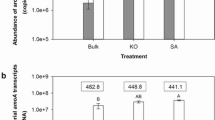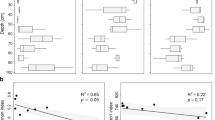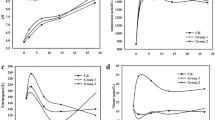Abstract
Purpose
Seagrasses accelerate sedimentation, release oxygen and organic matter through their roots, and compete with ammonia oxidizers for ammonia/ammonium in surface sediments and overlying water, all of which can influence benthic aerobic nitrification. To understand the effects of seagrass vegetation on benthic nitrification, the heterogeneity of nitrification activities and functional microbial communities between seagrass-vegetated and adjacent bare sediments was investigated.
Materials and methods
Surface (0–5 cm) sediments were sampled from a Zostera marina-colonized coastal lagoon in northern China. The potential nitrification rates (PNR) and relative contributions of ammonia-oxidizing bacteria (PNRaob) and ammonia-oxidizing archaea (PNRaoa) were determined based on the sediment slurry incubation with kanamycin inhibition method. The abundances and community compositions of ammonia-oxidizing bacteria (AOB) and ammonia-oxidizing archaea (AOA) were determined using qPCR, clone library, and high-throughput sequencing.
Results and discussion
The total PNR (PNRtotal) in the seagrass-colonized sediments were significant higher than those in the bare sediments (P < 0.05), to which PNRaob contributed 59.7% and 55.8% in vegetated and unvegetated sediments, respectively. The concentrations of chlorophyll a and dissolved inorganic nitrogen were key factors determining benthic PNR. AOB outnumbered AOA by one order of magnitude by targeting amoA gene abundance, and no significant difference (P > 0.05) in amoA gene abundance and diversity was observed between the two habitats. Most AOB genotypes were affiliated to Nitrosomonas, of which NL7 was selectively enriched in the vegetated region, while N. cryotolerans prevailed in the bare. Two distinct AOA groups Crenarchaeota 1.1b and Crenarchaeota 1.1a dominated in vegetated and unvegetated sediments, respectively. Dissolved oxygen of overlying water and TOC:TN of sediment significantly influenced AOB community, while AOA community was strongly driven by nitrate and metal iron in sediments.
Conclusions
Seagrass vegetation substantially enhances nitrification potential and selects specific ammonia oxidizers in coastal sediments.





Similar content being viewed by others
References
Ando Y, Nakagawa T, Takahashi R, Yoshihara K, Tokuyama T (2009) Seasonal changes in abundance of ammonia-oxidizing archaea and ammonia-oxidizing bacteria and their nitrification in sand of an eelgrass zone. Microbes Environ 24:21–27. https://doi.org/10.1264/jsme2.ME08536
Aoki LR, McGlathery KJ, Oreska MPJ (2020) Seagrass restoration reestablishes the coastal nitrogen filter through enhanced burial. Limnol Oceanogr 65:1–12. https://doi.org/10.1002/lno.11241
Barbier EB, Hacker SD, Kennedy C, Koch EW, Stier AC, Silliman BR (2011) The value of estuarine and coastal ecosystem services. Ecol Monogr 81:169–193. https://doi.org/10.1890/10-1510.1
Bayer B, Vojvoda J, Offre P, Alves RJE, Elisabeth NH, Garcia JAL, Volland JM, Srivastava A, Schleper C, Herndl GJ (2016) Physiological and genomic characterization of two novel marine thaumarchaeal strains indicates niche differentiation. ISME J 10:1051–1063. https://doi.org/10.1038/ismej.2015.200
Beman M, Francis C (2007) Diversity of ammonia-oxidizing archaea and bacteria in the sediments of a hypernutrified subtropical estuary: Bahía del Tóbari, Mexico. Appl Environ Microbiol 72:7767–7777. https://doi.org/10.1128/AEM.00946-06
Berg C, Vandieken V, Thamdrup B, Juergens K (2015) Significance of archaeal nitrification in hypoxic waters of the Baltic Sea. ISME J 9:1319–1332. https://doi.org/10.1038/ismej.2014.218
Berounsky VM, Nixon SW (1985) Eutrophication and the rate of net nitrification in a coastal marine ecosystem. Estuar Coast Shelf S 20:773–781. https://doi.org/10.1016/0272-7714(85)90032-0
Bouskill NJ, Tang J, Riley WJ, Brodie EL (2012) Trait-based representation of biological nitrification: model development, testing, and predicted community composition. Front Microbiol 3:364. https://doi.org/10.3389/fmicb.2012.00364
Caffrey J, Kemp WM (1990) Nitrogen cycling in sediments with estuarine populations of Potamogeton perfoliatus and Zostera marina. Mar Ecol Prog Ser 66:147–160. https://doi.org/10.3354/meps066147
Cao HL, Li M, Hong YG, Gu JD (2011) Diversity and abundance of ammonia-oxidizing archaea and bacteria in polluted mangrove sediment. Syst Appl Microbiol 34:513–523. https://doi.org/10.1016/j.syapm.2010.11.023
Chan YK, McCormick WA, Ma BL (2013) Effects of inorganic fertilizer and manure on soil archaeal abundance at two experimental farms during three consecutive rotation-cropping seasons. Appl Soil Ecol 68:26–35. https://doi.org/10.1016/j.apsoil.2013.03.004
Cole JR, Wang Q, Fish JA, Chai BL, McGarrell DM, Sun YN, Brown CT, Porras-Alfaro A, Kuske CR, Tiedje JM (2014) Ribosomal Database Project: data and tools for high throughput rRNA analysis. Nucleic Acids Res 42:D633–D642. https://doi.org/10.1093/nar/gkt1244
Dai LL, Liu CG, Yu LQ, Song CF, Peng L, Li XL, Tao L, Li G (2018) Organic matter regulates ammonia-oxidizing bacterial and archaeal communities in the surface sediments of Ctenopharyngodon idellus Aquaculture Ponds. Front Microbiol 9:2290. https://doi.org/10.3389/fmicb.2018.02290
Dang CY, Liu W, Lin YX, Zheng MS, Jiang H, Chen Q, Ni JR (2018) Dominant role of ammonia-oxidizing bacteria in nitrification due to ammonia accumulation in sediments of Danjiangkou reservoir, China. Appl Microbiol Biotechnol 102:3399–3410. https://doi.org/10.1007/s00253-018-8865-0
Darriba D, Taboada GL, Doallo R, Posada D (2011) ProtTest 3: fast selection of best-fit models of protein evolution. Bioinformatics 27:1164–1165. https://doi.org/10.1093/bioinformatics/btr088
Fish JA, Chai BL, Wang Q, Sun YN, Brown CT, Tiedje JM, James RC (2013) FunGene: the functional gene pipeline and repository. Front Microbiol 4:291. https://doi.org/10.3389/fmicb.2013.00291
Francis CA, Roberts KJ, Beman JM, Santoro AE, Oakley BB (2005) Ubiquity and diversity of ammonia-oxidizing archaea in water columns and sediments of the ocean. Proc Natl Acad Sci U S A 102:14683–14688. https://doi.org/10.1073/pnas.0506625102
Hall TA (1999) BioEdit: a user friendly biological sequence alignment editor and analysis program for windows 95/98/NT. Nucleic Acids Symp Ser 41:95–98
Hatzenpichler R, Lebedeva EV, Spieck E, Stoecker K, Richter A, Daims H, Wagner M (2008) A moderately thermophilic ammonia-oxidizing crenarchaeote from a hot spring. Proc Natl Acad Sci U S A 105:2134–2139. https://doi.org/10.1073/pnas.0708857105
Hauxwell J, Cebrian J, Valiela I (2003) Eelgrass Zostera marina loss in temperate estuaries: relationship to land-derived nitrogen loads and effect of light limitation imposed by algae. Mar Ecol Prog Ser 247:59–73. https://doi.org/10.3354/meps247059
He H, Zhen Y, Mi TZ, Fu LL, Yu ZG (2018) Ammonia-oxidizing archaea and bacteria differentially contribute to ammonia oxidation in sediments from adjacent waters of Rushan Bay, China. Front Microbiol 9:116. https://doi.org/10.3389/fmicb.2018.00116
Iizumi H, Hattori A, McRoy CP (1980) Nitrate and nitrite in interstitial waters of eelgrass beds in relation to the rhizosphere. J Exp Mar Biol Ecol 47:191–201. https://doi.org/10.1016/0022-0981(80)90112-4
Jensen HL (1950) Effect of organic compounds on Nitrosomonas. Nature 165:974–974
Jia Z, Conrad R (2009) Bacteria rather than archaea dominate microbial ammonia oxidation in an agricultural soil. Environ Microbiol 11:1658–1671. https://doi.org/10.1111/j.1462-2920.2009.01891.x
Jiang QQ, Bakken LR (1999) Comparison of Nitrosospira strains isolated from terrestrial environments. FEMS Microbiol Ecol 30:171–186. https://doi.org/10.1111/j.1574-6941.1999.tb00646.x
Jones RD, Morlta RY, Koops HP, Watson S (1988) A new marine oxidizing bacterium, Nitrosornonas cryotolerans sp. nov. Can J Microbiol 34:1122–1128. https://doi.org/10.1139/m88-198
Könneke M, Bernhard AE, de la Torre JR, Walker CB, Waterbury JB, Stahl DA (2005) Isolation of an autotrophic ammonia-oxidizing marine archaeon. Nature 437:543–546. https://doi.org/10.1038/nature03911
Koops HP, Pommerening-Röser A (2001) Distribution and ecophysiology of the nitrifying bacteria emphasizing cultured species. FEMS Microbiol Ecol 37:1–9. https://doi.org/10.1016/S0168-6496(01)00137-4
Koops HP, Böttcher B, Möller UC, Pommerening-Röser A, Stehr G (1991) Classification of eight new species of ammonia-oxidizing bacteria: Nitrosomonas communis sp. nov., Nitrosomonas ureae sp. nov., Nitrosomonas aestuarii sp. nov., Nitrosomonas marina sp. nov., Nitrosomonas nitrosa sp. nov., Nitrosomonas eutropha sp. nov., Nitrosomonas oligotropha sp. nov. and Nitrosomonas halophila sp. nov. J Gen Microbiol 137:1689–1699
Krümmel A, Harms H (1982) Effect of organic matter on growth and cell yield of ammonia-oxidizing bacteria. Arch Microbiol 133:50–54
Laanbroek HJ, Gerards S (1993) Competition for limiting amounts of oxygen between Nitrosomonas europaea and Nitrobacter winogradskyi grown in mixed continuous cultures. Arch Microbiol 159:453–459
Laanbroek HJ, Bodelier PLE, Gerards S (1994) Oxygen consumption kinetics of Nitrosomonas europaea and Nitrobacter hamburgensis grown in mixed continuous cultures at different oxygen concentrations. Arch Microbiol 161:156–162
Lehtovirta-Morley LE, Ross J, Hink L, Weber EB, Gubry-Rangin C, Thion C, Prosser J, Nicol G (2016) Isolation of “Candidatus Nitrosocosmicus franklandus”, a novel ureolytic soil archaeal ammonia oxidiser with tolerance to high ammonia concentration. FEMS Microbiol Ecol 92:fiw057. https://doi.org/10.1093/femsec/fiw057
Li M, Cao HL, Hong YG, Gu JD (2011) Spatial distribution and abundances of ammonia-oxidizing archaea (AOA) and ammonia-oxidizing bacteria (AOB) in mangrove sediments. Appl Microbiol Biotechnol 89:1243–1254. https://doi.org/10.1007/s00253-010-2929-0
Li JL, Nedwell DB, Beddow J, Dumbrell AJ, McKew BA, Thorpe EL, Whitby C (2015) amoA gene abundances and nitrification potential rates suggest that benthic ammonia-oxidizing bacteria and not archaea dominate N cycling in the Colne Estuary, United Kingdom. Appl Environ Microbiol 81:159–165. https://doi.org/10.1128/AEM.02654-14
Ling J, Lin XC, Zhang YY, Zhou WG, Yang QS, Lin LY, Zeng SQ, Zhang Y, Wang C, Ahmad M, Long LJ, Dong JD (2018) Community composition and transcriptional activity of ammonia-oxidizing prokaryotes of seagrass Thalassia hemprichii in coral reef ecosystems. Front Microbiol 9:7. https://doi.org/10.3389/fmicb.2018.00007
Liu Y, Liu YZ, Ding YJ, Zheng JW, Zhou T, Pan GX, Crowley D, Li LQ, Zheng JF, Zhang XH, Yu XY, Wang JF (2014) Abundance, composition and activity of ammonia oxidizer and denitrifier communities in metal polluted rice paddies from South China. PLoS One 9:e102000. https://doi.org/10.1371/journal.pone.0102000
Martens-Habbena W, Berube PM, Urakawa H, de la Torre JR, Stahl DA (2009) Ammonia oxidation kinetics determine niche separation of nitrifying archaea and bacteria. Nature 461:976–979. https://doi.org/10.1038/nature08465
Martikainen P, Nurmiaho-Lassila EL (2011) Nitrosospira, an important ammonium-oxidizing bacterium in fertilized coniferous forest soil. Can J Microbiol 31:190–197. https://doi.org/10.1139/m85-037
Ochsenreiter T, Selezi D, Quaiser A, Bonch-Osmolovskaya L, Schleper C (2003) Diversity and abundance of Crenarchaeota in terrestrial habitats studied by 16S RNA surveys and real time PCR. Environ Microbiol 5:787–797. https://doi.org/10.1046/j.1462-2920.2003.00476.x
Ottosen LDM, Risgaard-Petersen N, Nielsen LP (1999) Direct and indirect measurements of nitrification and denitrification in the rhizosphere of aquatic macrophytes. Aquat Microb Ecol 19:81–91. https://doi.org/10.3354/ame019081
Pal L, Kraigher B, Brajer-Humar B, Levstek M, Mandic-Mulec I (2012) Total bacterial and ammonia-oxidizer community structure in moving bed biofilm reactors treating municipal wastewater and inorganic synthetic wastewater. Bioresour Technol 110:135–143. https://doi.org/10.1016/j.biortech.2012.01.130
Park HD, Noguera DR (2007) Characterization of two ammonia-oxidizing bacteria isolated from reactors operated with low dissolved oxygen concentrations. J Appl Microbiol 102:1401–1417. https://doi.org/10.1111/j.1365-2672.2006.03176.x
Park BJ, Park SJ, Yoon DN, Schouten S, Sinninghe Damsté JS, Rhee SK (2010) Cultivation of autotrophic ammonia-oxidizing archaea from marine sediments in coculture with sulfur-oxidizing bacteria. Appl Environ Microbiol 76:7575–7587. https://doi.org/10.1128/AEM.01478-10
Prosser JI, Nicol GW (2008) Relative contributions of archaea and bacteria to aerobic ammonia oxidation in the environment. Environ Microbiol 10:2931–2941. https://doi.org/10.1111/j.1462-2920.2008.01775.x
Prosser JI, Nicol GW (2012) Archaeal and bacterial ammonia-oxidisers in soil: the quest for niche specialization and differentiation. Trends Microbiol 20:523–531. https://doi.org/10.1016/j.tim.2012.08.001
Purkhold U, Wagner M, Timmermann G, Pommerening-Röser A, Koops HP (2003) 16S rRNA and amoA-based phylogeny of 12 novel betaproteobacterial ammonia-oxidizing isolates: extension of the dataset and proposal of a new lineage within the Nitrosomonads. Int J Syst Evol Microbiol 53:1485–1494. https://doi.org/10.1099/ijs.0.02638-0
Rotthauwe JH, Witzel KP, Liesack W (1997) The ammonia monooxygenase structural gene amoA as a functional marker: Molecular fine-scale analysis of natural ammonia-oxidizing populations. Appl Environ Microbiol 63:4704–4712. https://doi.org/10.1128/aem.63.12.4704-4712.1997
Rysgaard S, RisgaardPetersen N, Sloth NP (1996) Nitrification, denitrification, and nitrate ammonification in sediments of two coastal lagoons in Southern France. Hydrobiologia 329:133–141
Schleper C (2010) Ammonia oxidation: different niches for bacteria and archaea? ISME J 4:1092–1094. https://doi.org/10.1038/ismej.2010.111
Schloss PD, Handelsman J (2005) Introducing DOTUR, a computer program for defining operational taxonomic units and estimating species richness. Appl Environ Microbiol 71:1501–1506. https://doi.org/10.1128/AEM.71.3.1501-1506.2005
Schloss PD, Westcott SL, Ryabin T, Hall JR, Hartmann M, Hollister EB, Lesniewski RA, Oakley BB, Parks DH, Robinson CJ, Sahl JW, Stres B, Thallinger GG, Van Horn DJ, Weber CF (2009) Introducing mothur: open-source, platform-independent, community-supported software for describing and comparing microbial communities. Appl Environ Microbiol 75:7537–7541. https://doi.org/10.1128/AEM.01541-09
Stahl DA, de la Torre JR (2012) Physiology and diversity of ammonia-oxidizing archaea. Annu Rev Microbiol 66:83–101. https://doi.org/10.1146/annurev-micro-092611-150128
Stamatakis A (2014) RAxML version 8: a tool for phylogenetic analysis and post-analysis of large phylogenies. Bioinformatics 30:1312–1313. https://doi.org/10.1093/bioinformatics/btu033
Stieglmeier M, Klingl A, Alves RJE, Rittmann SKR, Melcher M, Leisch N, Schleper C (2014) Nitrososphaera viennensis gen. nov., sp. nov., an aerobic and mesophilic, ammonia-oxidizing archaeon from soil and a member of the archaeal phylum Thaumarchaeota. Int J Syst Evol Microbiol 64:2738–2752. https://doi.org/10.1099/ijs.0.063172-0
Sun FF, Zhang XL, Zhang QQ, Liu FH, Zhang JP, Gong J (2015) Seagrass (Zostera marina) colonization promotes the accumulation of diazotrophic bacteria and alters the relative abundances of specific bacterial lineages involved in benthic carbon and sulfur cycling. Appl Environ Microbiol 81:6901–6914. https://doi.org/10.1128/AEM.01382-15
Sun DY, Tang XF, Zhao MY, Zhang ZX, Hou LJ, Liu M, Wang BZ, Klümper U, Han P (2020) Distribution and diversity of comammox nitrospira in coastal wetlands of China. Front Microbiol 11:589268. https://doi.org/10.3389/fmicb.2020.589268
Suzuki I, Dular U, Kwok SC (1974) Ammonia or ammonium ion as substrate for oxidation by Nitrosomonas europaea cells and extracts. J Bacteriol 120:556–558
Tal Y, Watts JEM, Schreier SB, Sowers KR, Schreier HJ (2003) Characterization of the microbial community and nitrogen transformation processes associated with moving bed bioreactors in a closed recirculated mariculture system. Aquaculture 215:187–202. https://doi.org/10.1016/S0044-8486(02)00372-1
Taylor AE, Zeglin LH, Dooley S, Myrold DD, Bottomley PJ (2010) Evidence for different contributions of archaea and bacteria to the ammonia-oxidizing potential of diverse Oregon Soils. Appl Environ Microbiol 76:7691–7698. https://doi.org/10.1128/AEM.01324-10
Taylor AE, Zeglin LH, Wanzek TA, Myrold DD, Bottomley PJ (2012) Dynamics of ammonia-oxidizing archaea and bacteria populations and contributions to soil nitrification potentials. ISME J 6:2024–2032. https://doi.org/10.1038/ismej.2012.51
Thandar SM, Ushiki N, Fujitani H, Sekiguchi Y, Tsuneda S (2016) Ecophysiology and comparative genomics of Nitrosomonas mobilis Ms1 isolated from autotrophic nitrifying granules of wastewater treatment bioreactor. Front Microbiol 7:1869. https://doi.org/10.3389/fmicb.2016.01869
Tourna M, Stieglmeier M, Spang A, Könneke M, Schintlmeister A, Urich T, Engel M, Schloter M, Wagner M, Richter A, Schleper C (2011) Nitrososphaera viennensis, an ammonia oxidizing archaeon from soil. Proc Natl Acad Sci U S A 108:8420–8425. https://doi.org/10.1073/pnas.1013488108
van Kessel MAHJ, Speth DR, Albertsen M, Nielsen PH, Op den Camp HJM, Kartal B, Jetten MSM, Lücker S (2015) Complete nitrification by a single microorganism. Nature 528:555–559. https://doi.org/10.1038/nature16459
Wang HT, Su JQ, Zheng TL, Yang XR (2015) Insights into the role of plant on ammonia-oxidizing bacteria and archaea in the mangrove ecosystem. J Soils Sediments 15:1212–1223. https://doi.org/10.1007/s11368-015-1074-x
Wang XM, Wang SY, Shi GS, Wang WD, Zhu GB (2019) Factors driving the distribution and role of AOA and AOB in Phragmites communis rhizosphere in riparian zone. J Basic Microbiol 59:425–436. https://doi.org/10.1002/jobm.201800581
Waycott M, Duarte CM, Carruthers TJB, Orth RJ, Dennison WC, Olyarnik S, Calladine A, Fourqurean JW, Heck KLJ, Hughes AR, Kendrick GA, Kenworthy WJ, Short FT, Williams SL (2009) Accelerating loss of seagrasses across the globe threatens coastal ecosystems. Proc Natl Acad Sci U S A 106:12377–12381. https://doi.org/10.1073/pnas.0905620106
Wessén E, Nyberg K, Jansson JK, Hallin S (2010) Responses of bacterial and archaeal ammonia oxidizers to soil organic and fertilizer amendments under long-term management. Appl Soil Ecol 45:193–200. https://doi.org/10.1016/j.apsoil.2010.04.003
Zarnoch CB, Hoellein TJ, Furman BT, Peterson BJ (2017) Eelgrass meadows, Zostera marina (L.), facilitate the ecosystem service of nitrogen removal during simulated nutrient pulses in Shinnecock Bay, New York, USA. Mar Pollut Bull 124:376–387. https://doi.org/10.1016/j.marpolbul.2017.07.061
Zhang JP, Liu B, Zhou XH, Chu JY, Li YM, Wang MY (2015a) Effects of emergent aquatic plants on abundance and community structure of ammonia-oxidising microorganisms. Ecol Eng 81:504–513. https://doi.org/10.1016/j.ecoleng.2015.04.029
Zhang Y, Chen LJ, Dai TJ, Sun RH, Wen DH (2015b) Ammonia manipulates the ammonia-oxidizing archaea and bacteria in the coastal sediment-water microcosms. Appl Microbiol Biotechnol 99:6481–6491. https://doi.org/10.1007/s00253-015-6524-2
Zheng YL, Hou LJ, Newell S, Liu M, Zhou JL, Zhao H, You LL, Cheng XL (2014) Community dynamics and activity of ammonia-oxidizing prokaryotes in intertidal sediments of the Yangtze estuary. Appl Environ Microbiol 80:408–419. https://doi.org/10.1128/AEM.03035-13
Funding
This work was jointly supported by the Natural Science Foundation of China (No. 41676154, 41976115), the grant from the Strategic Priority Research Program of the Chinese Academy of Sciences (No. XDA23050303), the Key Research and Development project of Yantai (2017ZH095), the Key Research Program of Frontier Sciences of CAS (No. QYZDB-SSW-DQC013, QYZDB-SSW-DQC041), the China Postdoctoral Science Foundation (No. 2019M653151), and the Fundamental Research Funds for the Central Universities (No. 19lgpy93, 181gzd07).
Author information
Authors and Affiliations
Corresponding authors
Ethics declarations
Human and animal rights and informed consent
The article does not contain any studies with human participants or animals.
Conflict of interest
The authors declare no competing interests.
Additional information
Responsible editor: Hongbin Yin
Publisher’s note
Springer Nature remains neutral with regard to jurisdictional claims in published maps and institutional affiliations.
Supplementary Information
ESM 1
(DOC 247 kb)
Rights and permissions
About this article
Cite this article
Lin, X., Zheng, P., Zou, S. et al. Seagrass (Zostera marina) promotes nitrification potential and selects specific ammonia oxidizers in coastal sediments. J Soils Sediments 21, 3259–3273 (2021). https://doi.org/10.1007/s11368-021-02951-w
Received:
Accepted:
Published:
Issue Date:
DOI: https://doi.org/10.1007/s11368-021-02951-w




